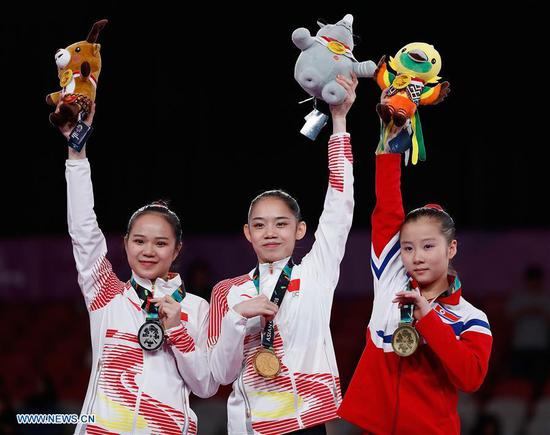Editor's Note: Jimmy Zhu is chief strategist at Fullerton Markets. The article reflects the author’s opinion, and not necessarily the views of CGTN.
The Chinese yuan’s rally in 2017 started from the introduction of a counter-cyclical factor in daily fixing in May.
That same factor can well explain the rapid gain seen in the yuan last Friday, when the People's Bank of China (PBOC) said such an adjustment mechanism had resumed.
This time around, sustainable gains in the yuan can’t only rely on a counter-cyclical factor, as the yuan’s upcoming outlook will still largely depend on differentiation between the US and China's monetary policies.
Background: The use of the counter-cyclical factor in yuan fixing in 2017
Many market participants may not be familiar with the details of counter-cyclical factors, so here is some background.
Before May 2017, the PBOC’s yuan fixing rate was mainly decided by the onshore yuan’s closing price during the previous trading day and the yuan’s value against a basket of currencies.
After May 2017, yuan-fixing banks needed to add the counter-cyclical factor into their yuan reference rate setting, and the coefficient needed to be adjusted according to macroeconomic conditions and pro-cyclical market sentiments.
The dollar index dropped more than five percent in the first five months of 2017.
Instead of tracking the moves in the dollar index, the USD/CNY rate kept hovering around the 6.9 levels over that period without many gains. This showed the yuan remained under depreciation pressure even with a soft dollar. Hence, the PBOC introduced the use of a counter-cyclical factor in May to offer the yuan some support.
In January 2018, when the yuan had almost gained eight percent versus the dollar since the introduction of the counter-cyclical factor seven months earlier, the central bank asked yuan-fixing banks to abandon this methodology when calculating the daily RMB rate.
Why has the PBOC resumed using the counter-cyclical factor this time?
This is the second time that the PBOC has tweaked its FX management strategy this month.
On August 3, the PBOC said that it would impose a reserve requirement of 20 percent on some trading of FX forward contracts. Prior to that announcement, the yuan was trading at rates as weak as 6.8960 versus the dollar.
Last Friday, the onshore yuan softened to as low as 6.8903 against the greenback.
Each time an announcement has been made concerning adjustments to FX management, the timing has coincided with USD/CNY rates nearing 7.0, giving the market the impression that any exchange rate near this key psychological level is currently unfavorable.
Coincidentally,the USD/CNY exchange rate was also around 6.9 last May, when the PBOC introduced the counter-cyclical factor.
In that case, should the USD/CNY exchange rate move close towards 6.9 again in the near term, some of the dollar-buy positions would likely have some misgivings about the onset of another round of potential administrative or monetary measures.
The yuan’s value against a basket of currencies could also be one of the key considerations for the PBOC in resuming the counter-cyclical factor.
The CFETS RMB index is currently around 92 – almost the same level as in May last year, when the yuan fixing formula was tweaked.
After the PBOC reformed its fixing methodology three years ago, one of its key policy objectives was to maintain a stable yuan against the basket of currencies.
Will the yuan return to its 2017 'rally pattern' with this round of using a counter-cyclical factor?
This time around, it's not likely. The methodology behind the counter-cyclical factor itself is to mitigate pro-cyclical trading activities, and not as something to reverse current trends.
Some of the fundamentals currently influencing exchange rates are very different to what they looked like in 2017.
Firstly, the dollar index was on a downtrend throughout 2017, but that’s not the case this year.
When the yuan was one of the worst performers among the major currencies in the first five months of 2017, prices that rallied after the fixing formula tweaks were more or less a “catch-up”.
Besides that, the onshore yuan gained around 5.3 percent from June to December in 2017 versus the dollar, while the dollar index fell 5.7 percent during this period, which was a pretty “fair match”.
Secondly, the spread between the China/US 10-year bonds yield has been shrinking this year, but it was widening in 2017 when the PBOC was following the Fed to tighten monetary policy by hiking reverse repo rates.
However, monetary policies between the two economies have shown some divergence this year. The Fed has raised rates twice this year, with a third one in September looking like a sure bet. Meanwhile, the PBOC has lowered the reserve requirement ratio to some banks three times so far this year.
Pros and Cons
Pros: China’s FX market is still not that mature compared to some other developed markets, and this is only the third year since the PBOC reformed the fixing regime in 2015. Some irrational expectations and examples of herd behavior are a result of the increasing risk of price overshooting.
Cons: Some market participants say that adopting the counter-cyclical factor will slow the progress of the yuan on its way to becoming a market-oriented currency, as it pulls away the fixings from where markets would set it.


















































